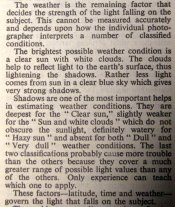Roll film does not allow N-1 (unless the scenes are the same type). Thus, Ansel Adams does not come to the rescue here.
Try to forget shadows here: we all know that fill light lightens them. I am talking about the SUNLIT portions of the scene and to simplify, let's focus upon ONLY a grey scale fully lit by sun. Would exposures in either case be identical or different. I think different. - David Lyga
I would think that the difference in fill light provided by blue sky vs. clouds would be minimal in relation to the strength of the direct sunlight in the sunlit areas of your scene. Negligible enough that your grey scales in direct sunlight would be, for all practical purposes, identical. It's only the shadows that would show a significant difference in your scene.
Two different scenarios:
1: A subject in direct flat sunlight from a cloudless sky coming from behind the camera position with no shadows at all except maybe for limb effects.
2. A landscape with significant important shadows (hillsides, tree shadows, etc.) lit by direct sunlight from a cloudless sky.
Now, add clouds to the above. Scenario one will not change appreciably; the predominant light source is and remains the sun alone. The light added from the clouds is negligible. Scenario 2, however, is going to have more light in the shadows; perhaps significantly more if the blue sky is very dark, as it is at high altitudes, and if the clouds are positioned and illuminated so that they provide significant fill light to the shadows. And the color temperature of the light illuminating the shadows is going to be different as well, affecting possible filter choice. I can imagine up to a stop difference in the shadows in extreme cases.
(...and, BTW, you can develop roll film to N-1 if you like, or use a different contrast grade paper to achieve basically the same thing. That's not the issue here, and certainly has no bearing on a subject in flat sunlight.)
Best,
Doremus






